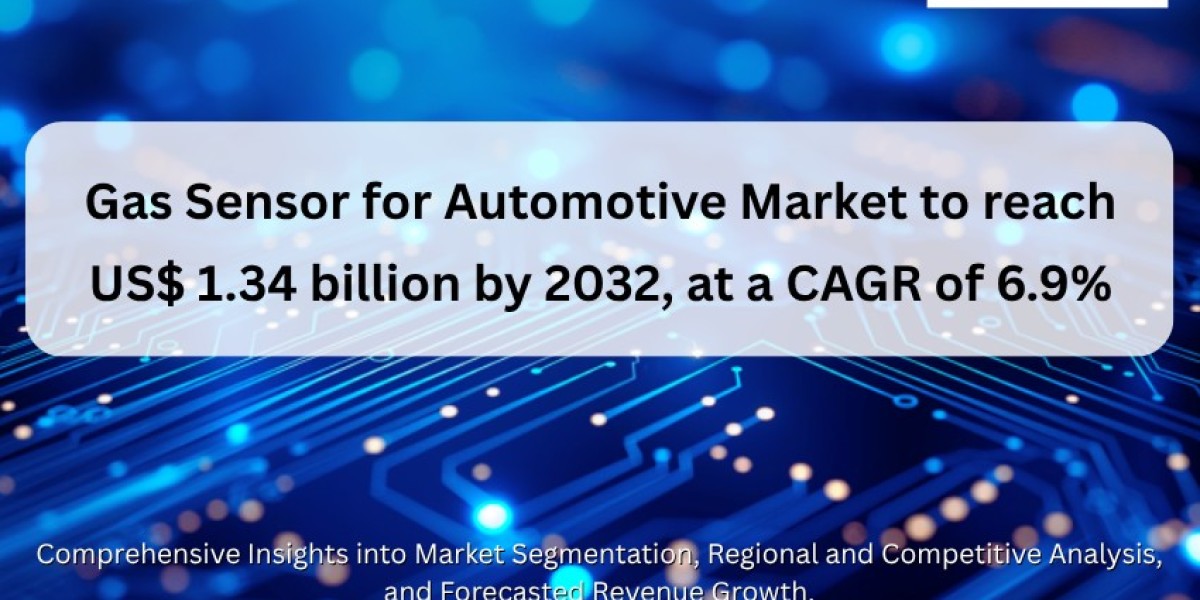Global Gas Sensor for Automotive Market size was valued at US$ 789.4 million in 2024 and is projected to reach US$ 1.34 billion by 2032, at a CAGR of 6.9% during the forecast period 2025-2032.
Gas sensors for automotive are critical components that detect and measure the concentration of gases in vehicle environments. These sensors convert gas-related data into electrical signals for processing by the vehicle’s electronic control units (ECUs). They play a vital role in monitoring emissions, optimizing combustion efficiency, and ensuring passenger safety by detecting hazardous gases like carbon monoxide.
The market growth is primarily driven by stringent global emission regulations such as Euro 7 and China 6 standards, which mandate sophisticated emission control systems. Furthermore, the rising adoption of advanced driver-assistance systems (ADAS) and electric vehicles creates new opportunities for sensor integration. Key industry players including Bosch, Continental, and DENSO are investing heavily in developing more accurate and durable sensor technologies to meet these evolving demands.
Get Full Report : https://semiconductorinsight.com/report/gas-sensor-for-automotive-market/
MARKET DYNAMICS
MARKET DRIVERS
Stringent Emission Regulations Accelerating Adoption of Gas Sensors
The global automotive industry is witnessing unprecedented regulatory pressure to reduce emissions, with governments implementing progressively stricter standards. The Euro 7 norms scheduled for 2025 aim to reduce NOx emissions by 35% compared to current limits, compelling automakers to incorporate more sophisticated exhaust monitoring systems. Similarly, China’s China 6b standards and the U.S. EPA’s Tier 3 regulations are creating mandatory demand for high-precision gas sensors. This regulatory push isn’t limited to exhaust systems – evaporative emission control systems in fuel tanks now require vapor detection sensors meeting 0.02g/hr sensitivity thresholds, expanding the addressable market further.
Electrification Wave Creating New Sensing Requirements
While battery electric vehicles eliminate tailpipe emissions, they introduce new gas sensing challenges that are driving innovation. Lithium-ion battery thermal runaway events can produce hazardous gases including hydrogen fluoride (HF) at concentrations as low as 30ppm. Advanced cabin air quality systems now integrate multiple gas sensors to detect CO2 buildup from occupant breathing (typically above 1000ppm triggers ventilation) and volatile organic compounds. Emerging solid-state battery technologies are creating demand for novel hydrogen sulfide (H2S) sensors capable of detecting concentrations below 1ppm to monitor cell degradation.
ADAS Integration Expanding Sensor Functionality
Advanced driver assistance systems are evolving to incorporate environmental sensing capabilities that go beyond traditional collision avoidance. Modern implementations now integrate gas sensors with predictive algorithms – detecting rising CO levels in tunnels can trigger cabin air recirculation before oxygen depletion becomes dangerous. Some premium vehicles now feature methane detection systems that alert drivers to gas leaks when parked in residential garages, with sensitivity thresholds below 10% of the lower explosive limit (LEL). This sensor fusion approach is creating opportunities for multi-gas detection modules that interface directly with vehicle ECUs.
MARKET RESTRAINTS
Thermal and Chemical Stability Challenges in Harsh Environments
Automotive gas sensors face extreme operating conditions that push material science boundaries. Under-hood applications require sensors to maintain accuracy across a -40°C to 125°C temperature range while exposed to vibration loads exceeding 20G. Electrochemical sensors particularly struggle with electrolyte evaporation at high temperatures, leading to calibration drift. Recent field studies show particulate contamination can reduce nitrogen oxide sensor lifespan by up to 40% in diesel applications. While new alumina-based protective coatings show promise, they add approximately 15-20% to unit costs, creating adoption barriers in price-sensitive segments.
Complex Validation Requirements Increasing Time-to-Market
The automotive industry’s rigorous qualification processes create significant bottlenecks for new sensor technologies. A typical OEM approval cycle now spans 18-24 months, requiring validation across 50+ environmental and durability tests. Redundant sensor architectures needed for ASIL-D compliance in safety-critical applications can increase system costs by 30-35%. Recent changes in ISO 26262 functional safety standards have mandated additional failure mode documentation, with some Tier 1 suppliers reporting 40% longer development cycles for new sensor integrations.
MARKET OPPORTUNITIES
AI-Enabled Predictive Maintenance Creating Value-Added Services
Vehicle connectivity is enabling innovative business models around gas sensor data monetization. Cloud-based analytics platforms now correlate sensor outputs with drive cycle data to predict emission system failures with 85-90% accuracy 3,000-5,000 miles before they occur. Some fleet operators have reduced NOx-related warranty claims by 60% using these predictive models. Emerging applications include real-time fuel quality monitoring through hydrocarbon pattern recognition, helping detect adulterated fuels that can cause aftertreatment system damage.
Material Science Breakthroughs Enabling New Sensing Modalities
Recent advances in nanomaterials are overcoming traditional limitations of gas sensors. Graphene-based FET sensors demonstrate parts-per-billion sensitivity to NO2 at room temperature, eliminating traditional heater power requirements. Metal-organic framework (MOF) materials show exceptional selectivity for oxygenates like ethanol and formaldehyde, enabling new cabin air quality applications. These innovations are particularly significant for hydrogen fuel cell vehicles, where current sensors struggle with cross-sensitivity between hydrogen and other reducing gases.
MARKET CHALLENGES
Supply Chain Vulnerabilities Impacting Sensor Availability
The gas sensor industry faces critical material dependencies that create supply risks. Over 75% of global platinum group metal production – essential for electrochemical sensors – comes from just three countries, making pricing volatile. Recent geopolitical tensions have caused rhodium prices to fluctuate by ±40% in 12-month periods, directly impacting sensor manufacturing costs. Silicon carbide shortages for MEMS-based sensors have extended lead times to 52+ weeks, forcing redesigns of next-generation products.
Standardization Gaps Hindering Technology Adoption
The lack of unified protocols for sensor data communication creates integration challenges. While SAE J1939 dominates heavy-duty applications, passenger vehicles use at least six competing protocols including SENT, PSI5, and LIN. This fragmentation increases development costs by requiring multiple interface ASICs. Emerging challenges include cybersecurity requirements for connected sensors, with recent UNECE WP.29 regulations mandating secure boot and encrypted communications for all safety-related components.
GAS SENSOR FOR AUTOMOTIVE MARKET TRENDS
Stringent Emission Regulations Driving Adoption of Advanced Gas Sensors
The global gas sensor for automotive market is experiencing accelerated growth due to tightening emission standards across major automotive markets. With Europe’s Euro 7 norms and China’s China 6 standards imposing stricter limits on nitrogen oxides (NOx) and particulate matter, automakers are being compelled to integrate more sophisticated gas sensing technologies. Recent data indicates that emission-related gas sensors now account for over 65% of the total automotive sensor market. This regulatory push is further amplified by real-time monitoring requirements in modern vehicles, creating sustained demand for high-accuracy sensors that can operate in harsh automotive environments while maintaining long-term reliability.
Other Trends
Electrification and Hybrid Vehicle Integration
While battery electric vehicles (BEVs) eliminate tailpipe emissions, they still require precise thermal runaway detection sensors for battery safety. The rapid growth of hybrid vehicles—projected to represent 30% of global car sales by 2030—is creating demand for dual-purpose sensors that monitor both combustion emissions and cabin air quality. These systems are becoming increasingly integrated with vehicle telematics, enabling predictive maintenance alerts based on gas sensor data patterns.
Advancements in Solid-State and MEMS Sensor Technologies
The shift towards MEMS (Micro-Electro-Mechanical Systems) based gas sensors is transforming the market landscape. These miniature sensors offer faster response times (<1 second for CO detection) and consume 60% less power than traditional electrochemical sensors—critical for electric vehicle applications. Furthermore, NDIR (Non-Dispersive Infrared) sensors are gaining adoption for their superior accuracy in measuring CO2 levels, with some advanced models achieving ±20ppm precision. Recent collaborations between semiconductor companies and automotive OEMs are accelerating the development of multi-gas detection chips that combine up to 5 sensing technologies in a single package.
COMPETITIVE LANDSCAPE
Key Industry Players
Innovation and Strategic Expansion Drive Market Leadership
The global gas sensor for automotive market features a dynamic and evolving competitive landscape, characterized by a mix of established players and emerging innovators. Robert Bosch and Continental dominate the market, collectively holding a significant share due to their extensive R&D investments and strong global supply chains. These companies benefit from robust partnerships with automotive OEMs, enabling them to integrate advanced sensors into next-generation vehicles.
DENSO Corporation and Sensata Technologies have also solidified their positions as key market players, particularly in exhaust and intake gas sensor segments. Their growth is propelled by the increasing demand for emission control solutions, especially in regions with stringent environmental regulations such as Europe and North America.
While the market is competitive, smaller players like Cubic Sensor and Instrument and Zhengzhou Weisheng Electronic are gaining traction by focusing on cost-effective solutions tailored for emerging markets. These companies leverage localized manufacturing and agile innovation to capture niche opportunities in Asia-Pacific and Latin America.
In response to rising demand for electric and hybrid vehicles, key players are intensifying their efforts to develop sensors compatible with alternative fuel systems. For instance, Infineon Technologies recently launched a new line of hydrogen sensors targeted at fuel-cell vehicles, reflecting the industry’s shift toward sustainable mobility solutions.
List of Key Gas Sensor for Automotive Companies Profiled
- Robert Bosch (Germany)
- Continental AG (Germany)
- DENSO Corporation (Japan)
- Sensata Technologies (U.S.)
- Delphi Technologies (U.K.)
- Infineon Technologies (Germany)
- Valeo (France)
- Hitachi Automotive Systems (Japan)
- Autoliv (Sweden)
- ZF Friedrichshafen (Germany)
- Bourns, Inc. (U.S.)
- Cubic Sensor and Instrument (China)
- Zhengzhou Weisheng Electronic (China)
- Hanwei Electronics Group (China)
- Luftmy Intelligence Technology (China)
Segment Analysis:
By Type
Exhaust Gas Sensor Segment Dominates Due to Stringent Emission Regulations
The market is segmented based on type into:
- Exhaust Gas Sensor
- Subtypes: Oxygen (O2) sensors, NOx sensors, Particulate Matter sensors, and others
- Intake Gas Sensor
- Subtypes: Mass airflow sensors, Manifold absolute pressure sensors, and others
- Cabin Air Quality Sensors
- Battery Gas Sensors (for EV applications)
By Application
Passenger Vehicle Segment Leads Due to Increased Vehicle Production and Consumer Demand
The market is segmented based on application into:
- Passenger Vehicles
- Commercial Vehicles
- Electric Vehicles
- Hybrid Vehicles
By Technology
Electrochemical Sensors Remain Prevalent Due to Cost-Effectiveness
The market is segmented based on technology into:
- Electrochemical Sensors
- Infrared Sensors
- Semiconductor Sensors
- Catalytic Sensors
By Vehicle Type
Internal Combustion Vehicles Hold Majority Share Due to Existing Fleet
The market is segmented based on vehicle type into:
- Gasoline Vehicles
- Diesel Vehicles
- Electric Vehicles
Regional Analysis: Gas Sensor for Automotive Market
North America
The North American market is leading in technological adoption and regulatory compliance, driven by stringent EPA and CARB emission standards. The U.S. holds the largest share, with OEMs integrating advanced exhaust and intake gas sensors to meet Tier 3 and LEV IV norms. The shift toward electrification is reshaping demand, with hybrid vehicles requiring dual-purpose sensors for both combustion and battery safety monitoring. Collaboration between Robert Bosch and Sensata Technologies has accelerated innovations in MEMS-based gas sensing solutions for improved accuracy.
Europe
Europe’s market thrives under the Euro 7 emission standards, pushing automakers to adopt NOx and particulate sensors at scale. Germany and France dominate production, with Continental and Infineon developing low-power, high-durability sensors for luxury and commercial vehicles. The EU’s 2025 carbon neutrality targets have spurred R&D investments in hydrogen fuel cell sensors, particularly for heavy-duty transport. However, high costs and complex integration with legacy vehicle architectures remain hurdles for widespread adoption in Eastern Europe.
Asia-Pacific
As the largest and fastest-growing market, Asia-Pacific is fueled by China’s China 6 norms and India’s BS-VI regulations, creating a $420M annual demand for gas sensors. Japanese suppliers like DENSO lead in compact sensor designs, while local players such as Zhengzhou Weisheng cater to cost-sensitive segments. The region’s EV boom is driving innovation in battery thermal runaway detection sensors. However, inconsistent enforcement of emission laws in Southeast Asia limits growth potential outside major automotive hubs.
South America
Market progress is uneven, with Brazil accounting for 60% of regional demand due to its Proconve L7 emission standards. Economic instability has delayed sensor upgrades in Argentina and Colombia, though aftermarket demand for O2 sensors is rising. The lack of localized production forces reliance on imports, inflating costs by ~20% compared to other regions. Recent trade agreements with Asian manufacturers could improve accessibility to affordable sensor solutions.
Middle East & Africa
The GCC countries are prioritizing vehicle safety standards, creating niche opportunities for cabin air quality sensors in premium vehicles. Saudi Arabia and the UAE are investing in sensor-equipped smart city fleets, but adoption lags in Africa due to minimal emission regulations. South Africa remains the only significant market, with Autoliv and ZF supplying sensors to European OEMs’ local plants. The region’s harsh climate conditions drive demand for dust- and corrosion-resistant sensor designs.
Get A Detailed Sample Report : https://semiconductorinsight.com/download-sample-report/?product_id=97965
Report Scope
This market research report provides a comprehensive analysis of the Global and regional Gas Sensor for Automotive markets, covering the forecast period 2025–2032. It offers detailed insights into market dynamics, technological advancements, competitive landscape, and key trends shaping the industry.
Key focus areas of the report include:
- Market Size & Forecast: Historical data and future projections for revenue, unit shipments, and market value across major regions and segments. The market was valued at USD 907 million in 2024 and is projected to reach USD 2147 million by 2032 at a CAGR of 13.4%.
- Segmentation Analysis: Detailed breakdown by product type (Exhaust Gas Sensor, Intake Gas Sensor), application (Passenger Vehicle, Commercial Vehicle), and technology to identify high-growth segments.
- Regional Outlook: Insights into market performance across North America, Europe, Asia-Pacific, Latin America, and the Middle East & Africa, including country-level analysis.
- Competitive Landscape: Profiles of leading market participants including Robert Bosch, Continental, DENSO, Sensata Technologies, and Delphi, covering their product portfolios, market share, and strategic developments.
- Technology Trends & Innovation: Assessment of emerging sensor technologies, integration with ADAS/autonomous systems, and advancements in emission control solutions.
- Market Drivers & Restraints: Analysis of stringent emission regulations, fuel efficiency demands, technological challenges, and cost factors impacting market growth.
- Stakeholder Analysis: Strategic insights for automotive OEMs, sensor manufacturers, component suppliers, and investors regarding market opportunities and challenges.
The research employs both primary and secondary methodologies, including interviews with industry experts and analysis of verified market data to ensure accuracy and reliability.
Customization of the Report
In case of any queries or customization requirements, please connect with our sales team, who will ensure that your requirements are met.
Related Reports :
https://semiconductorinsight.com/report/12-inch-semiconductor-silicon-wafer-market/
https://semiconductorinsight.com/report/global-gesture-sensor-market/
https://semiconductorinsight.com/report/iris-recognition-access-control-system-market/
https://semiconductorinsight.com/report/thermistor-temperature-sensor-market-2/
https://dineshsemiconductorsinsightspr.blogspot.com/2025/06/automatic-defrost-controller-market.html
https://dineshsemiconductorsinsightspr.blogspot.com/2025/06/ddr4-ram-market-to-reach-us-18600.html
https://dineshsemiconductorsinsightspr.blogspot.com/2025/06/synchro-to-digital-converter-market.html
https://dineshsemiconductorsinsightspr.blogspot.com/2025/06/active-laser-medium-market-global.html
https://dineshsemiconductorsinsightspr.blogspot.com/2025/06/led-display-module-market-emerging.html








